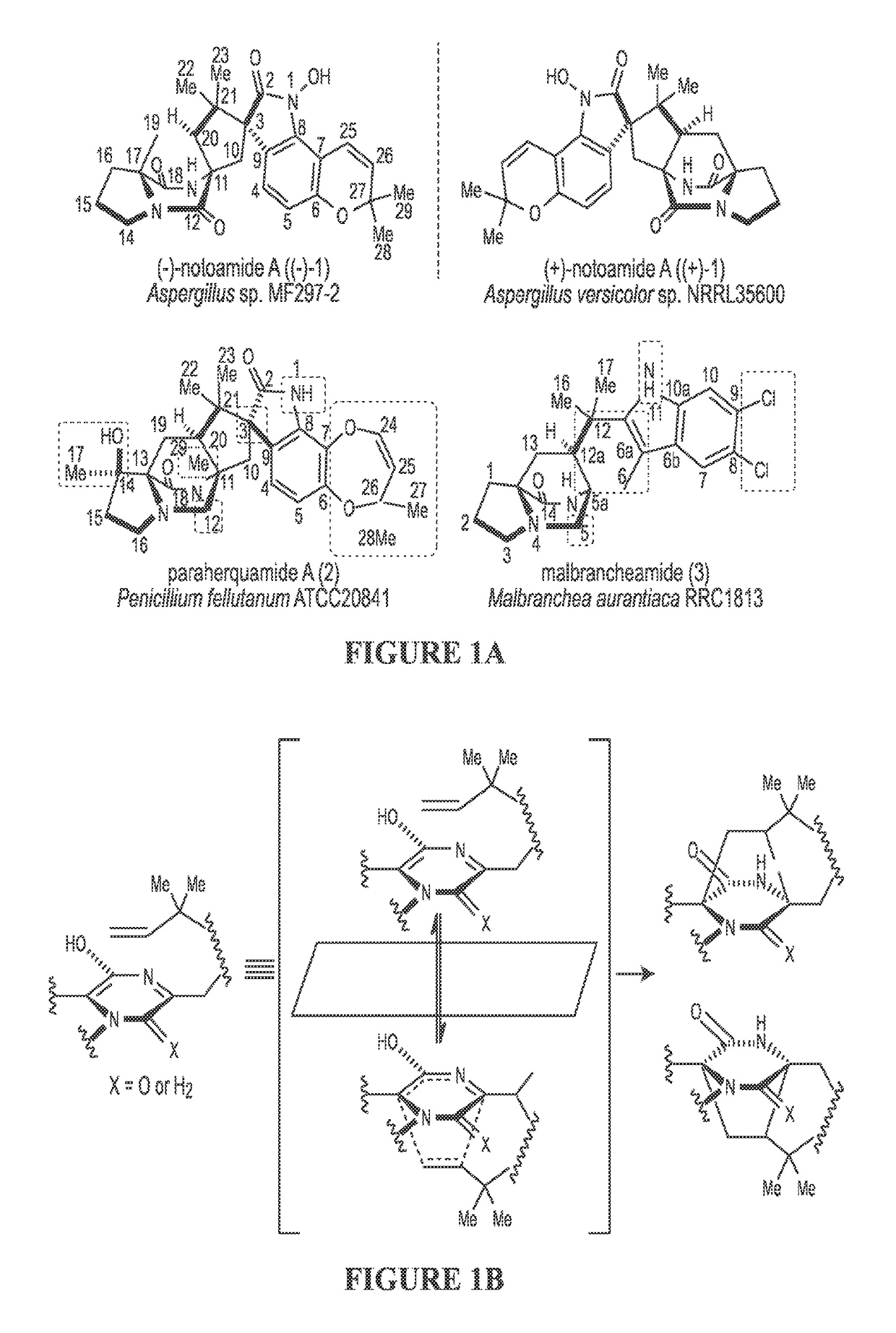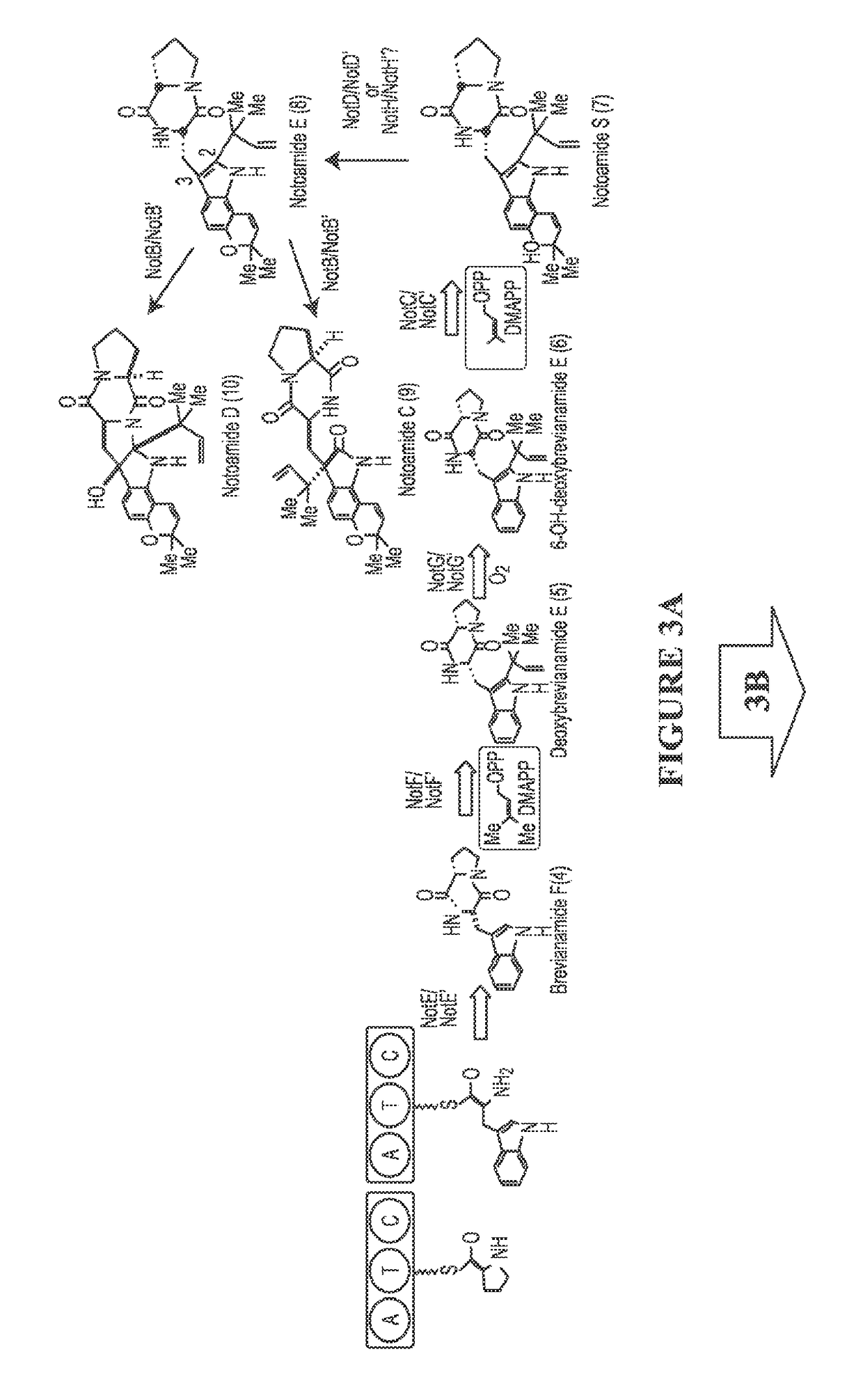Biosynthetic systems producing fungal indole alkaloids
a biosynthetic system and fungal indole technology, applied in the direction of alkaloids, transferases, drug compositions, etc., can solve the problems of insufficient knowledge of biosynthetic origin, inability to verify putative biochemical function in vitro using natural or suitable model substrates, and inability to achieve the effect of reducing the number of bacterial indole alkaloids
- Summary
- Abstract
- Description
- Claims
- Application Information
AI Technical Summary
Problems solved by technology
Method used
Image
Examples
example 1
[0111]The genomes of A. versicolor NRRL35600, P. fellutanum ATCC20841, and M. aurantiaca RRC1813A harboring not′, phq, and mal gene clusters, respectively were sequenced to approximately 99, 84, and 181 times coverage of their estimated genome size (35 Mb), using the Illumina Solexa technology (Genome Analyzer IIx).
[0112]First, the key biosynthetic gene notE′ (Table 1) encoding a non-ribosomal peptide synthetase (NRPS) was mined from the genome sequences using the notE DNA sequence from the reported not gene cluster43 as a probe for homologous genes. NotE′, which shows 79% identity and 86% similarity to NotE at the amino acid (AA) level, was predicted to be a bimodular NRPS with the A-T-C-A-T-C (A: adenylation, T: thiolation, C: condensation) domain organization using the PKS / NRPS Analyzer. Genome walking from notE′ toward 5′ and 3′ ends identified another nine genes (notA′-J′, Table 1 and FIG. 2) that display high AA sequence similarity (>70%) with corresponding gene products of th...
example 2
[0116]Since the discovery of the biosynthetic gene cluster of (−)-1 from marine Aspergillus sp. MF297-2, in vitro biochemical characterization of the reverse prenyltransferase NotF using the NRPS (NotE) product brevianamide F53 (4) as substrate and the normal prenyltransferase NotC using 6-hydroxy-deoxybrevianamide E (6) as substrate has partially established the early steps of the notoamide pathway leading to notoamide S (7) (FIG. 3).43 The P450 monooxygenase NotG is likely catalyzing the C6 indole hydroxylation since its close homologue FtmC (59% / 72% identity / similarity) in fumitremorgin biosynthesis had been characterized to hydroxylate the analogous aromatic C—H bond in the indole ring of tryprostatin B,54,55 which is structurally similar to deoxybrevianamide E (5).56
[0117]As the proposed pivotal branching point in notoamide biosynthesis,47,57,58 7 can be diverted to notoamide E (8) through an oxidative pyran ring closure putatively catalyzed by either NotH P450 monooxygenase (...
example 3
[0121]Previous feeding studies demonstrated that L-isoleucine is the precursor to the β-methyl-β-hydroxy proline moiety in 2.45,63 Identification of the pyrroline-5-carboxylate reductase PhqD and the short chain dehydrogenase PhqE from phq cluster suggests a reasonable pathway from L-isoleucine to β-methyl proline (FIG. 4). Similar to the partially identified biosynthesis of 4-methyl proline in cyanobacterial Nostoc sp.,64 PhqE presumably oxidizes the terminally hydroxylated L-isoleucine (by an unknown enzyme) to the corresponding aldehyde. Spontaneous cyclization and dehydration would yield the 4-methyl pyrolline-5-carboxylic acid, which is then reduced by PhqD leading to the β-methyl proline precursor.
[0122]The presence of a C-terminal NAD(P)-dependent reductase domain in the bimodular paraherquamide NRPS (A-T-C-A-T-R) clearly indicates that the mechanism for dipeptide release by PhqB must be different from the final condensation domain of NotE (FIG. 3).50 What likely occurs is th...
PUM
| Property | Measurement | Unit |
|---|---|---|
| genome size | aaaaa | aaaaa |
| absolute chirality | aaaaa | aaaaa |
| structure | aaaaa | aaaaa |
Abstract
Description
Claims
Application Information
 Login to View More
Login to View More - R&D
- Intellectual Property
- Life Sciences
- Materials
- Tech Scout
- Unparalleled Data Quality
- Higher Quality Content
- 60% Fewer Hallucinations
Browse by: Latest US Patents, China's latest patents, Technical Efficacy Thesaurus, Application Domain, Technology Topic, Popular Technical Reports.
© 2025 PatSnap. All rights reserved.Legal|Privacy policy|Modern Slavery Act Transparency Statement|Sitemap|About US| Contact US: help@patsnap.com



